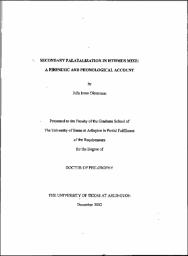
ATTENTION: The works hosted here are being migrated to a new repository that will consolidate resources, improve discoverability, and better show UTA's research impact on the global community. We will update authors as the migration progresses. Please see MavMatrix for more information.
Show simple item record
| dc.contributor.author | Dieterman, Julia Irene | |
| dc.date.accessioned | 2020-10-09T19:31:52Z | |
| dc.date.available | 2020-10-09T19:31:52Z | |
| dc.date.issued | 2002-12 | |
| dc.identifier.uri | http://hdl.handle.net/10106/29496 | |
| dc.description.abstract | This dissertation is a study of the process of palatalization in Isthmus Mixe, in which every consonant in the inventory has a palatalized counterpart. This type of palatalization occurring as a secondary [i]-like articulation, simultaneous to the primary articulation of the consonant (Bhat 1974, Ladefoged 1993), is defined as secondary palatalization by Keating (1993). Occurring word initially in Isthmus Mixe, the feature of secondary palatalization alone represents the grammatical third person morpheme, palatalizing the initial consonant of the noun or verb. There are also verbal suffixes that consist solely of secondary palatalization, indicating clause-type markers (Dieterman 1995, 1998), and a deverbalizer, that palatalize the final consonant(s) of the verb. Morpheme-induced secondary palatalization has been described in all of the Oaxacan Mixe languages; however, Isthmus Mixe is an undescribed language except for the recent work of the author of this dissertation. It is shown that the secondary palatalization feature in Isthmus Mixe modifies (mutates) the initial or final consonant(s) of the word and also the vowel(s) adjacent to the consonant. Spectrograms that show the transition formants of vowels adjacent to palatalized consonants support the claim that even the laryngeal consonants /h/ and /ʔ/ are subject to secondary palatalization. It is shown that representing secondary palatalization as an autosegmental feature may be used to describe all occurrences of morpheme-induced secondary palatalization and its phonetic effects on all of the consonants and vowels. Previous descriptions of other Mixe languages that were based on the linear phonemic model, obscured the phonetic reality of secondary palatalization and did not recognize secondary palatalization as a consonant mutation. Autosegmental features that are consonant mutations linked to morphemes have been described in a number of the world's languages. With this initial description of secondary palatalization in Isthmus Mixe, and references to secondary palatalization in all of the Oaxacan Mixe languages, it is hoped that these processes will become known to the wider linguistic community and also that further studies will be initiated in the Mixe-Zoque languages. | en_US |
| dc.language.iso | en_US | en_US |
| dc.publisher | University of Texas at Arlington | en_US |
| dc.subject | Language | en_US |
| dc.subject | Literature and linguistics | en_US |
| dc.subject | Isthmus Mixe | en_US |
| dc.subject | Mexico | en_US |
| dc.subject | Oaxacan | en_US |
| dc.subject | Phonetic | en_US |
| dc.subject | Phonological | en_US |
| dc.subject | Secondary palatalization | en_US |
| dc.title | SECONDARY PALATALIZATION IN ISTHMUS MIXE: A PHONETIC AND PHONOLOGICAL ACCOUNT | en_US |
| dc.type | Dissertation | en_US |
| thesis.degree.department | Linguistics | |
| thesis.degree.name | Doctor of Philosophy in Linguistics | |
Files in this item
- Name:
- Secondary Palatalization in ...
- Size:
- 7.395Mb
- Format:
- PDF
- Description:
- PDF
This item appears in the following Collection(s)
Show simple item record


